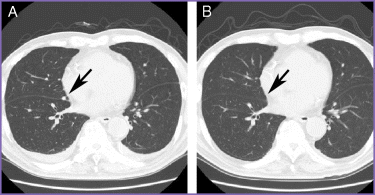-
PDF
- Split View
-
Views
-
Cite
Cite
M. Yamada, N. Hatta, M. Mizuno, N. Oishi, K. Takehara, Weekly low‐dose docetaxel in the treatment of lung metastases from angiosarcoma of the head, British Journal of Dermatology, Volume 152, Issue 4, 1 April 2005, Pages 811–812, https://doi.org/10.1111/j.1365-2133.2005.06503.x
Close - Share Icon Share
Sir, Cutaneous angiosarcoma is a rare aggressive malignant tumour usually occurring on the scalp of extremely elderly people. Patients with angiosarcoma of the head have a poor prognosis from the time of detection due to a high rate of local recurrence and haematogenous metastasis.1, 2 The most common metastatic sites are lung, liver, lymph nodes, bone and skin. Although treatments including surgical excision, radiation, polychemotherapy, OK432 and recombinant interleukin‐23–5 are performed alone or in combination for metastatic angiosarcoma, the prognosis remains desperately poor. We report a patient with pleural and lung metastasis of angiosarcoma of the head treated with docetaxel who showed a partial response.
A 75‐year‐old man presented with an 11‐month history of a haemorrhagic tumour on the front of the head. He underwent surgical excision of the tumour with a 3‐cm margin in November 2001 followed by 50 Gy of electron beam irradiation to the margin. The diagnosis of angiosarcoma was confirmed histologically. Systemic examination did not reveal any evidence of metastasis at this time. In November 2002, he complained of lower chest pain and pleural metastases with bilateral haemothorax were confirmed by computed tomography. The left haemothorax was treated with continuous drainage followed by an intrapleural OK432 injection into the space to induce sclerosis. At the same time, he commenced treatment with intravenous docetaxel 25 mg m−2 once weekly. To avoid fluid retention and an anaphylaxic reaction, he received oral prophylaxis with dexamethasone 2 mg daily for 2 days after docetaxel therapy.6 This cycle was repeated every 7 days for 3 weeks, followed by a 1‐week interval between courses.7 After one course of treatment, the right haemothorax and part of the nodular pleural metastasis had completely disappeared (Fig. 1), and his lower chest pain was markedly improved. He was discharged after two courses of treatment and continued another two courses as an outpatient. There were no adverse effects except for low‐grade neutropenia. Although the patient experienced disease stabilization for 5 months, spinal bone, lung and pleural metastasis rapidly developed and he died of respiratory failure in May 2003.

(A) Chest computed tomographic scan showing a small nodule in the right lung (arrow). (B) After one course of weekly low‐dose docetaxel treatment, the nodular lesion had completely disappeared.
Docetaxel and paclitaxel are new drugs that promote tubulin assembly into microtubules and stabilize microtubule formation by preventing depolymerization of the polymers formed.8 These agents are clinically useful in treating several types of solid tumours including breast, gastric, ovarian, nonsmall cell lung carcinoma and head and neck cancer.8, 9 A recent study has shown a good response to paclitaxel of angiosarcoma of the scalp or face.10 In comparison with paclitaxel, docetaxel produces less neurotoxicity, which is the most important determinant of tolerance to these agents.6 We were able to continue outpatient treatment without any severe side‐effects using a weekly low‐dose docetaxel regimen.7 Although the patient died of recurrent disease, complete clearance of lung metastasis and haemothorax showed the palliative efficacy of docetaxel, and the response was accompanied by an improvement in quality of life for the patient.



